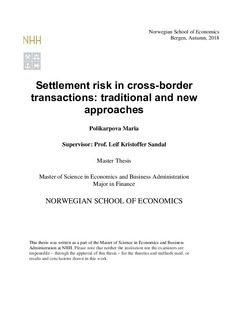| dc.description.abstract | Although the wholesale payment systems operate unnoticed daily, these arrangements are crucial for our daily life. In this thesis I attempt to shed more light on the settlement risk in traditional wholesale payment systems based on corresponding banking (CB) settlement, and the Continuous Linked Settlement (CLS) systems, and a new settlement system based on the Distributed Ledger Technology (DLT). The contemporary systems for cross-border payments are complex, costly, and fragmented, so, many companies and authorities are searching for a more viable solution to take advantage of modern technology, and for creation of a safe and efficient payment system. It is necessary to improve the interoperability among the local and global financial infrastructures in order facilitate and evolve international trade and development for all countries.
This thesis presents extended literature and computational analyses of the settlement risk duration and exposure for a simple high-value payment and FX spot deal between small-size financial institutions or corporates. The settlement based on the CB network, settlement via the CLS system, and the DLT-based settlement using Utility Settlement Coin (USC) are the main study objects.
The analysis results demonstrate that the settlement system based on CB expose its customers to a considerable settlement risk due to low transparency, tied-up liquidity, and time-consuming manual processes. The CLS system allows reducing the settlement risk for its direct participants, but the third parties are still face significant settlement risk exposure due to the linked CB parts.
This work demonstrates the a USC settlement system can alleviate the settlement risk by means of faster settlement (0.5-8 hours instead of 5-24 hours), end-to-end visibility, and greater trust in the time-critical and reliability-demanding wholesale cross-border payment system. The settlement delays in the USC-based system are mainly associated with overburden regulatory compliance checks and direct participants’ desire to delay the final transfer in order to optimize the liquidity usage through the day. | nb_NO |
